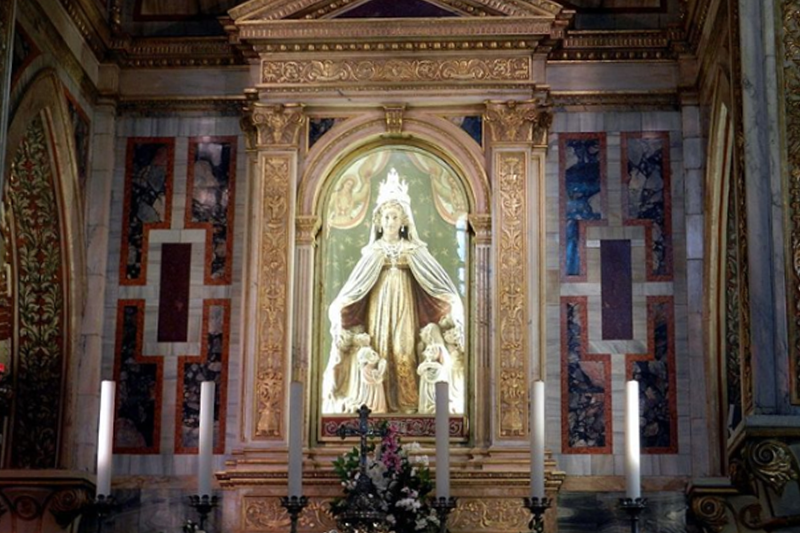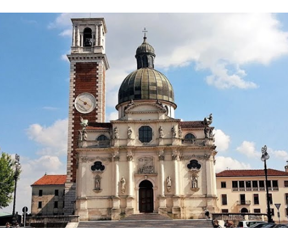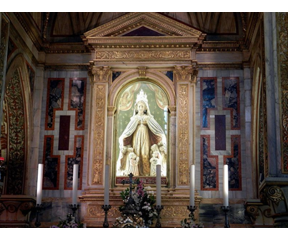Blogs

The Queen of a World of War
By Emma Donnelly
It’s easy to argue that human beings have been at war for our entire existence. Whether with nature or each other, conflict seems to be embedded in our human nature. But if people are trapped in a cycle of perpetual struggle, then how is it possible for us to believe in something that is purely good and perfect?
To answer this question, we look to the small city of Vicenza, Italy, in the year 1426. For more than two decades, the city had been overcome with a lethal and persistent plague. The people of Vicenza were locked in a deadly duel with nature, and they were losing. In this crumbling city, a victim of the war of the human world, the Blessed Virgin Mary reminded people of the saving power of God.
The Madonna of Monte Berico
Among the inhabitants of Vicenza in 1426 was 70-year-old Vincenza Pasini, whose husband owned a small vineyard. On March 7, 1426, while Vincenza was climbing the hillside of Monte Berico to bring lunch to her husband, who was working in the fields of the vineyard, she encountered a beautiful woman with garments more radiant than the sun and “wreathed in the fragrance of a thousand secrets.”
Overcome with wonder, Vincenza fell to the ground. As she lay in the dirt at the woman’s feet, the woman smiled and began to speak: “I am the Virgin Mary, the mother of Christ who died on the cross for the salvation of men,” she declared in a gentle, angelic voice. “I beg you to go and say in my name to the people of Vicenza that they must build in this place a church in my honor if they want to recover their health. Otherwise, the plague will not cease.”
Vincenza was overwhelmed with a sense of warmth. She lifted herself off the ground and onto her knees. With tears of joy rolling down her face, she knelt in front of Our Lady and asked what she had to do to convince people of the validity of her story.
In response, Mary told her, “You will insist so that my people do my will; otherwise they will never be rid of the plague—and, until they obey, they will see my Son angry with them.”
Then, Mary reached down and picked up a twig off the ground. Using the tip, she drew in the dirt the Sign of the Cross and the outline of the church that she had requested. When she was finished, she planted the twig into the ground to indicate the exact spot where the high altar of the church was to be built.
“As proof of what I say, let them dig here,” Mary directed, “and from the rock, living water will spring. As soon as the building begins, money will not lack.”
When she had finished, Mary disappeared.
Vincenza hurried into downtown Vicenza and relayed what she had witnessed to the local religious authorities, but they dismissed her, too concerned with the rampaging disease to give any thought to the old woman’s testimony.
The response was not what she had hoped for, but it didn’t shake Vincenza’s faith. She remained unscathed by the plague, and her charitable work aided many desperate community members. On feast days, Vincenza would climb Monte Berico and pray at the location where Our Lady had appeared to her.
On Aug. 1, 1428 — more than two years after the original apparition — Mary appeared to Vincenza again in the same location. During this visit, she repeated her initial request for a church to be built on that spot. She reiterated her message of faith and reminded Vincenza of her promise to end the plague if her request was fulfilled.
This time, Vincenza was not to be ignored. She ran into town and began to shout Our Lady’s message at the top of her lungs. Hearing her words, people began to feel hope pool in their hearts. The conditions had become so dire that the clergy listened. Construction of the church began on Aug. 25.
During construction, Mary’s promises, once seen as outlandish and preposterous, came true: A consistent flow of revenue came during the construction of the church. While the foundations were being dug in the bedrock where the Virgin had once stood, “a wonderful and incredible quantity of water welled out like a spring … overflowing like an abundant river that ran down the hill with great noise,” just as she had promised. The spring dried up after a century but was rediscovered in 1955 amidst excavation for a new convent.
Most importantly, the plague that had tormented the city for 24 years vanished following the completion of the church, which was named the Basilica of St. Mary of Monte Berico. From then on, the people of the city of Vicenza venerated the Virgin Mary as their savior and protector.
Our Lady of Monte Berico bestowed her saving grace on the city once more in 1917, amidst the annihilation of World War I. The fighting was closing in; the people in imminent danger, and their fields, which they relied on for income, were on the verge of destruction.
On Feb. 25, the citizens of Vicenza gathered at the foot of the high altar of the basilica and prayed for the intercession of Our Lady of Monte Berico to protect them and spare their lands. In return, they promised to keep the day of her birth (celebrated on Sept. 8) sacred and to celebrate it as a feast day.
Their prayers were answered. Although the war raged mere kilometers away, it never breached Vicenza’s walls, and the people and their livelihoods survived the war. Sept. 8 has been venerated as a local holiday in Vicenza ever since.
The Madonna of Monte Berico was officially declared the patron saint of Vicenza by Pope Paul VI on Jan. 11, 1978.
Mary’s Message to a War-Torn World
In a way, the plight of Vicenza represents that of the world. Wherever we turn, it seems we are faced with conflict. Whether it’s gun violence, poverty, natural disaster, or discord, we will always be met with a force of resistance while we are on this Earth.
The challenges we face help us grow closer to God. We struggle through trial and tribulation because we know there is something greater that is worth fighting for. Each triumph is a step closer to God; as Our Lady of Monte Berico teaches us, faith alone gives the courage to persevere.
As children of God, we are obligated to rise to the challenge and strive to create a better world. Only then will we be able to truly allow the love of God into our hearts.
— Emma Donnelly ’26 is a history major and a student employee in the Marian Library.


